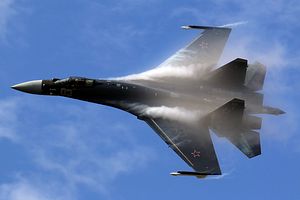The Russian Ministry of Defense (MoD) has confirmed this month that the last batch of ten Sukhoi Su-35S (NATO reporting name: Flanker-E) multirole fighter jets destined for service in the People’s Liberation Army Air Force (PLAAF) will be delivered on schedule by the end of 2018.
China became the first international customer of one of Russia’s most advanced fighter jets when it signed a $2.5 billion contract for 24 Su-35 fighter jets in November 2015. Contract negotiations between China and Russia over the purchase of the aircraft already began in 2011, with a preliminary agreement reached in 2012.
A first batch of four Su-35 fighter aircraft arrived at a flight training center of the PLAAF in Cangzhou City in Hebei province in northern China in December 2016. A second batch of 10 Su-35 fighter jets was delivered in December 2017. The last batch is expected to be delivered in middle to late December 2018. As I noted in May:
The Su-35 is an upgraded fourth generation, twin-engine, multirole air superiority fighter aircraft powered by two AL-117S turbofan engines and fitted with thrust vectoring nozzles allowing the aircraft to attain “super maneuverability”.
Additionally, the aircraft features “an export-standard radar system — the Irbis-E passive-electronically scanned-array radar, capable of tracking up to 30 targets simultaneously and purportedly able to engage up to eight — an electronic warfare and communications suite, as well as a newly integrated receiver for the domestically-built BeiDou satellite navigation system. (…)
The per-unit cost of a Su-35, the latest variant of Russia’s Flanker-series, is estimated at around $85 million.
Initially, Russia was reportedly reluctant to sell the fighter jets to China as it feared Chinese reverse engineering of the aircraft’s powerful AL-41F1S, alternatively known as the ALS-117S, thrust-vectoring engine despite Russian claims that it would be almost impossible to do so without breaking the engine.
Indeed, Beijing first was interested in procuring the AL-41F1S as a stand-alone product. However, this was quickly rebuffed by Moscow. The Chinese military aviation industry is still struggling with designing and building reliable engines for its military aircraft. Chinese-made engines continue to lack the power and durability of their Russian counterparts. Despite recent advances, China in particular struggles with turbofan or fanjet technology.
China’s next-generation high-performance turbofan jet engines such as the domestically developed WS-15 turbofan engine are underpowered and continue to show various performance issues. One of the principal reasons for the poor performance of China’s military aviation industry when it comes to the development and production of engines is that its past overreliance on reverse engineering has prevented the industry from obtaining the necessary know-how and experience that comes from prolonged R&D phases as well as infrastructural support.
Notably, PLAAF Su-35s for the first time escorted Xian H-6K bombers and support aircraft during a long-range patrol over the Bashi channel and around the island of Taiwan on May 11.































